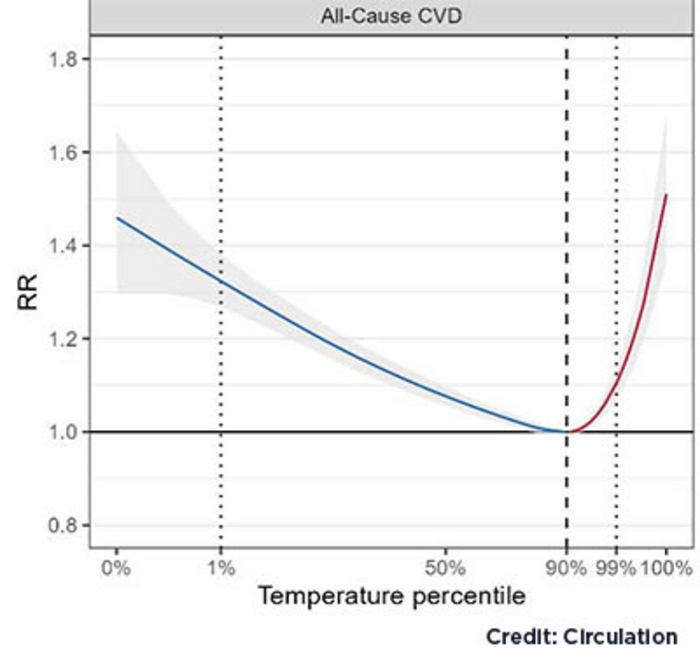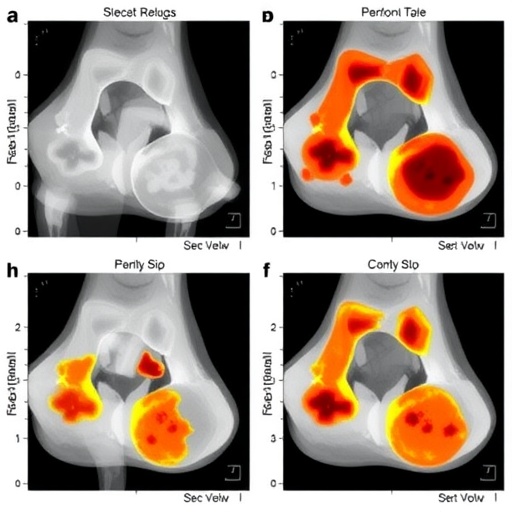Exposure to extremely hot or cold temperatures increases a heart disease patient’s risk of dying, according to a new study published today in the American Heart Association’s journal Circulation. The global analysis of more than 32 million cardiovascular deaths over 40 years measured more deaths on days when temperatures were at their highest or lowest compared to more moderate climate days.

Credit: Circulation
Exposure to extremely hot or cold temperatures increases a heart disease patient’s risk of dying, according to a new study published today in the American Heart Association’s journal Circulation. The global analysis of more than 32 million cardiovascular deaths over 40 years measured more deaths on days when temperatures were at their highest or lowest compared to more moderate climate days.
“It underscores the urgent need to develop measures that will help our society mitigate the impact of climate change on cardiovascular disease,” said study co-author Haitham Khraishah, MD, a cardiovascular disease fellow at the University of Maryland School of Medicine (UMSOM) and University of Maryland Medical Center (UMMC).
Among the types of cardiovascular disease, people with heart failure were most likely to be negatively impacted by very cold and very hot days, experiencing a 12 percent greater risk of dying on extreme heat days compared to optimal temperature days in a specific city. Extreme cold increased the risk of heart failure deaths by 37 percent.
Findings were based on an analysis of health data from more than 32 million cardiovascular deaths that occurred in 567 cities in 27 countries on 5 continents between 1979 and 2019. The definition of extreme weather differed from city to city. It was defined as the top 1 percent or bottom 1 percent of the “minimum mortality temperature,” which is the temperature at which the lowest death rate is achieved.
For every 1,000 cardiovascular deaths, the researchers found that:
Extreme hot days (above 86° F in Baltimore) accounted for 2.2 additional deaths.
Extreme cold days (below 20° F in Baltimore) accounted for 9.1 additional deaths.
Of the types of heart diseases, the greatest number of additional deaths was found for people with heart failure (2.6 additional deaths on extreme hot days and 12.8 on extreme cold days).
“While we do not know the reason why temperature effects were more pronounced with heart failure patients it could be due to the progressive nature of heart failure as a disease,” said Dr. Khraishah. “One out of four people with heart failure are readmitted to the hospital within 30 days of discharge, and only 20 percent of patients with heart failure survive 10 years after diagnosis.”
Climate change has been found to cause weather extremes on both ends of the spectrum with hotter summers and colder winters. A 2021 study published in the journal Science found that Arctic warming caused a change of events leading to a disruption of the polar vortex causing periods of extreme cold in the Northern hemisphere.
Barrak Alahmad, MD, PhD, research fellow at the Harvard T.H. Chan School of Public Health at Harvard University in Boston and a faculty member at the College of Public Health at Kuwait University in Kuwait City was the corresponding author of the study. Dr. Khraishah and Dr. Alahmad led an effort over the past four years to build the heart disease mortality database for this study with their colleagues from more than 35 institutions worldwide.
The team developed and expanded the heart disease mortality database as part of the Multi-Country Multi-City (MCC) Collaborative Research Network. This is a consortium of epidemiologists, biostatisticians and climate scientists studying the health impacts of climate and related environmental stressors on death rates.
“This study provides an indisputable link between extreme temperatures and heart disease mortality from one of the largest multinational datasets ever assembled,” said Mark T. Gladwin, MD, Dean, UMSOM, Vice President for Medical Affairs, University of Maryland, Baltimore, and the John Z. and Akiko K. Bowers Distinguished Professor. “The data can be more deeply mined to learn more about the role of health disparities and genetic predispositions that make some populations more vulnerable to climate change.”
Such questions will be addressed in future research, according to Dr. Khraishah.
Some limitations of the study include an underrepresentation of data from South Asia, the Middle East and Africa. It could be that extreme heat had more of an impact than initially measured due to this lack of data.
The researchers took into account humidity and air pollutants, which could have accounted for excess deaths in places of temperature extremes. They also controlled for the delayed effect of temperature on human health (lag effect) and climate zone.
“This landmark paper is a call to view climate change as a growing public health concern and highlights the need to investigate it as a potential cause of health disparities,” said Stephen N. Davis, MBBS, Chair of the Department of Medicine at UMSOM and Physician-in-Chief at UMMC.
This analysis was funded by the Kuwait Foundation for the Advancement of Science.
About the University of Maryland School of Medicine
Now in its third century, the University of Maryland School of Medicine was chartered in 1807 as the first public medical school in the United States. It continues today as one of the fastest growing, top-tier biomedical research enterprises in the world — with 46 academic departments, centers, institutes, and programs, and a faculty of more than 3,000 physicians, scientists, and allied health professionals, including members of the National Academy of Medicine and the National Academy of Sciences, and a distinguished two-time winner of the Albert E. Lasker Award in Medical Research. With an operating budget of more than $1.3 billion, the School of Medicine works closely in partnership with the University of Maryland Medical Center and Medical System to provide research-intensive, academic, and clinically based care for nearly 2 million patients each year. The School of Medicine has nearly $600 million in extramural funding, with most of its academic departments highly ranked among all medical schools in the nation in research funding. As one of the seven professional schools that make up the University of Maryland, Baltimore campus, the School of Medicine has a total population of nearly 9,000 faculty and staff, including 2,500 students, trainees, residents, and fellows. The combined School of Medicine and Medical System (“University of Maryland Medicine”) has an annual budget of over $6 billion and an economic impact of nearly $20 billion on the state and local community. The School of Medicine, which ranks as the 8th highest among public medical schools in research productivity (according to the Association of American Medical Colleges profile) is an innovator in translational medicine, with 606 active patents and 52 start-up companies. In the latest U.S. News & World Report ranking of the Best Medical Schools, published in 2021, the UM School of Medicine is ranked #9 among the 92 public medical schools in the U.S., and in the top 15 percent (#27) of all 192 public and private U.S. medical schools. The School of Medicine works locally, nationally, and globally, with research and treatment facilities in 36 countries around the world. Visit medschool.umaryland.edu
Journal
Circulation
Method of Research
Observational study
Subject of Research
People
Article Title
Associations Between Extreme Temperatures and Cardiovascular Cause-Specific Mortality
Article Publication Date
12-Dec-2022





